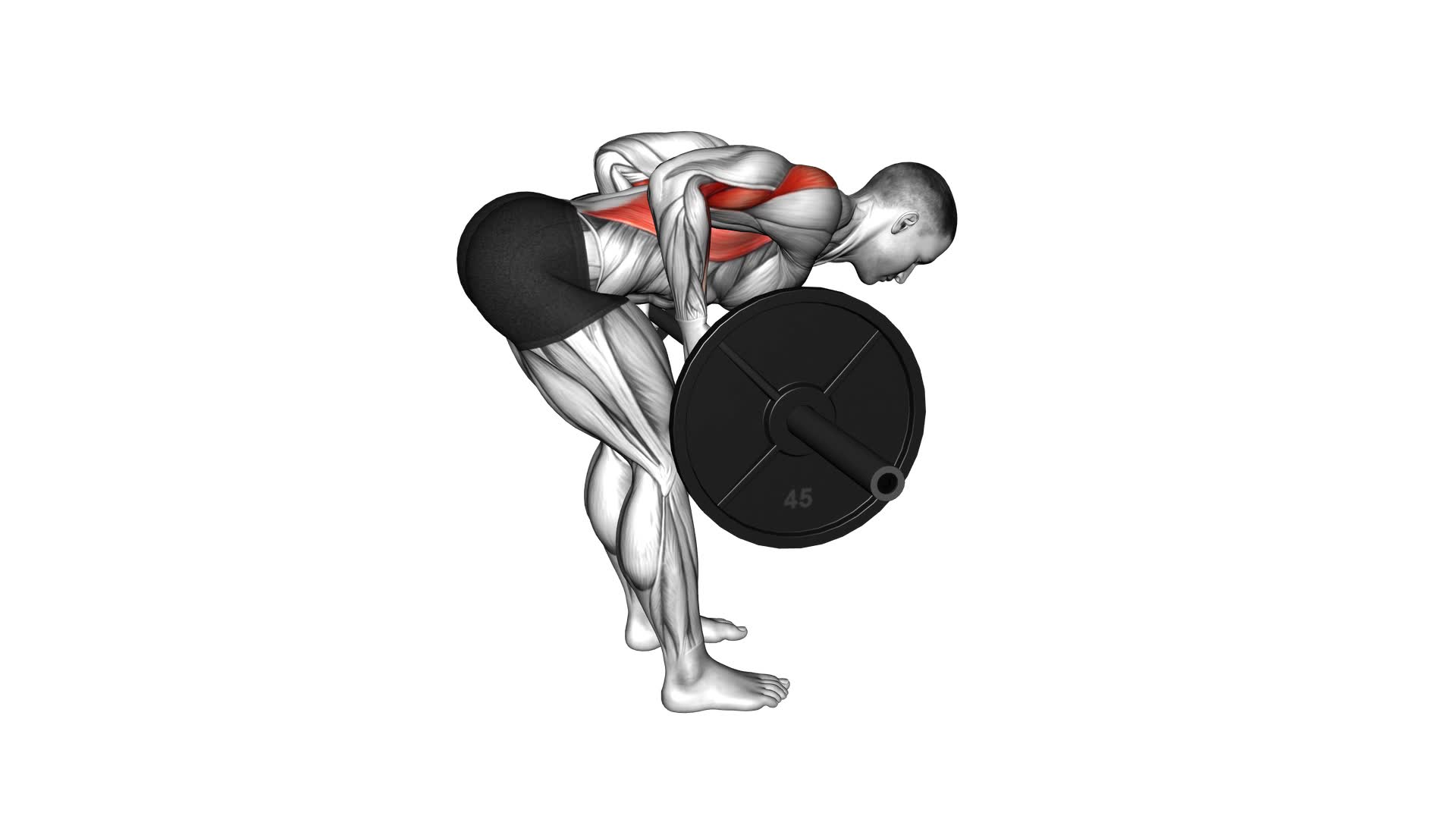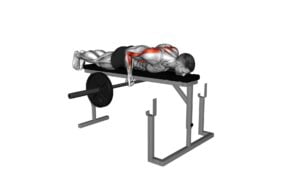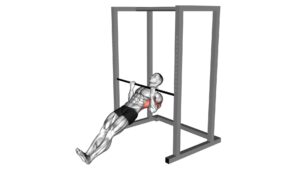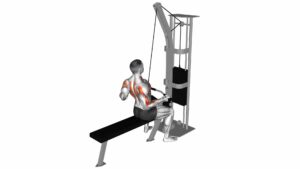Barbell Underhand Bent-over Row – Video Exercise Guide & Tips

Get ready to take your workout to the next level with the Barbell Underhand Bent-over Row. This exercise targets your back muscles while also engaging your biceps and core.
Watch This Exercise Video
In this video exercise guide, we'll show you the proper form and technique to maximize results and avoid common mistakes. Whether you're a beginner or a seasoned pro, we've got tips to help you increase intensity and progress.
Let's get started and achieve those fitness goals!
Key Takeaways
- The barbell underhand bent-over row targets back muscles, biceps, and core.
- It activates multiple muscle groups simultaneously, making it an efficient exercise.
- Proper form and technique, such as maintaining a straight back and controlled movements, are crucial for maximizing benefits and avoiding injuries.
- To increase intensity and progression, gradually increase weight, decrease rest time, incorporate supersets, use tempo variations, and aim for a specific rep and set range.
Benefits of the Barbell Underhand Bent-over Row
You will experience several benefits by incorporating the barbell underhand bent-over row into your workout routine. This exercise is highly effective at activating multiple muscle groups simultaneously, making it a great addition to any strength training program.
One of the main benefits of the barbell underhand bent-over row is its ability to target and engage your back muscles, specifically the lats, rhomboids, and traps. By performing this exercise, you can strengthen and develop these muscles, leading to improved posture and a more balanced physique.
Another advantage of the barbell underhand bent-over row is its impact on your overall posture. Many people spend a significant amount of time sitting or hunching over, which can lead to rounded shoulders and a forward head position. By incorporating this exercise into your routine, you can help counteract these negative effects by strengthening the muscles responsible for maintaining proper posture. This includes the muscles of your upper back and shoulders, which are heavily engaged during the barbell underhand bent-over row.
Proper Form and Technique for the Exercise
To execute the barbell underhand bent-over row with proper form and technique, focus on maintaining a strong and stable position throughout the exercise. Here are some key tips to help you perform the exercise correctly:
- Start by standing with your feet shoulder-width apart and your knees slightly bent. Hold the barbell with an underhand grip, hands shoulder-width apart.
- Bend forward at the hips, keeping your back straight and your head in line with your spine. Engage your core muscles to maintain stability.
- Pull the barbell up towards your lower chest, squeezing your shoulder blades together. Keep your elbows close to your body and your wrists neutral.
- Lower the barbell back down in a controlled manner, fully extending your arms before starting the next repetition.
Some common mistakes to avoid include using momentum to lift the weight, rounding your back, and pulling the barbell too high.
Remember to start with a weight that allows you to maintain proper form and gradually increase the intensity as you become stronger. By following these guidelines, you can maximize the benefits of the barbell underhand bent-over row while minimizing the risk of injury.
Common Mistakes to Avoid
Avoiding common mistakes is crucial when performing the barbell underhand bent-over row exercise. By being aware of these mistakes, you can avoid injury and maximize muscle engagement.
One common mistake to avoid is rounding your back during the exercise. This can put unnecessary strain on your spine and increase the risk of injury. Instead, focus on keeping your back straight and your core engaged throughout the movement.
Another mistake to avoid is using momentum to lift the weight. It's important to maintain control and perform the exercise with a slow and controlled motion. This will ensure that you're effectively targeting the muscles in your back and not relying on other muscles to assist in the movement.
Lastly, make sure to use the proper grip on the barbell. Using an underhand grip allows for better activation of the muscles in your upper back and biceps.
Now that you know the common mistakes to avoid, let's move on to the next section where we'll discuss tips for increasing intensity and progression in the barbell underhand bent-over row exercise.
Tips for Increasing Intensity and Progression
To increase intensity and progression in the barbell underhand bent-over row exercise, focus on incorporating progressive overload techniques. Here are some ways to modify the exercise and recommended rep and set ranges:
- Increase the weight: Gradually increase the amount of weight you use for each set. This will challenge your muscles and help you build strength over time.
- Decrease rest time: Shorten the rest periods between sets to keep your heart rate elevated and increase the overall intensity of the workout.
- Incorporate supersets: Pair the barbell underhand bent-over row with another exercise, such as push-ups or planks, to create a superset. This will work different muscle groups and add variety to your routine.
- Use tempo variations: Play around with the speed at which you perform each repetition. Slow down the eccentric (lowering) phase of the movement to increase time under tension and make the exercise more challenging.
For optimal results, aim for 8-12 reps and 3-4 sets of the barbell underhand bent-over row. Remember to listen to your body and adjust the weight and intensity as needed.
By incorporating these tips, you can effectively increase the intensity and progression of your barbell underhand bent-over row workout.
Now, let's move on to discuss variations and modifications for different fitness levels.
Variations and Modifications for Different Fitness Levels
In the article, we'll now explore variations and modifications for different fitness levels in the barbell underhand bent-over row exercise.
If you're a beginner, there are modifications you can make to ensure you perform the exercise safely and effectively. One option is to use lighter weights or even bodyweight to start with. This will allow you to focus on perfecting your form and building strength gradually. Another modification is to perform the exercise using a resistance band instead of a barbell. This can help with stability and reduce the risk of injury.
As you progress and become more advanced, there are variations you can incorporate to challenge yourself even further. One option is to perform the exercise on an unstable surface, such as a balance board or a stability ball. This will engage your core and challenge your balance. Another variation is to perform the exercise using a narrow underhand grip, which will target your biceps more intensely.
Frequently Asked Questions
How Many Sets and Reps Should I Do for the Barbell Underhand Bent-Over Row?
For the barbell underhand bent-over row, it's important to focus on the number of sets and reps that work best for you. Generally, a good starting point is to do 3-4 sets of 8-12 reps. This will help you build strength and muscle in your back, arms, and shoulders.
Keep in mind that everyone is different, so adjust the weight and reps based on your fitness level.
Can I Use Dumbbells Instead of a Barbell for This Exercise?
Yes, you can use dumbbells instead of a barbell for this exercise.
Using dumbbells for bent over rows is a great alternative to the barbell underhand bent over row.
It allows for a wider range of motion and can help target different muscles in your back.
Make sure to keep your form and technique consistent when using dumbbells, and start with lighter weights if you're new to this exercise.
Is It Safe to Perform the Barbell Underhand Bent-Over Row if I Have a Lower Back Injury?
If you have a lower back injury, it's important to prioritize your safety and avoid exercises that may exacerbate the condition. The barbell underhand bent-over row can put strain on the lower back, so it may not be the best choice for you.
Instead, consider alternative exercises that are gentle on the lower back, such as seated cable rows or single-arm dumbbell rows. These modifications can help you maintain your upper body strength while supporting your recovery.
Should I Use an Overhand Grip or an Underhand Grip for This Exercise?
To determine whether to use an overhand grip or an underhand grip for this exercise, consider your goals and comfort.
An overhand grip engages more of your back muscles, while an underhand grip targets your biceps and upper back.
Experiment with both grips to find which feels more natural and effective for you.
Remember to maintain proper form and listen to your body to avoid any strain or injury.
Can I Incorporate This Exercise Into a Full-Body Workout Routine?
Yes, you can definitely incorporate the Barbell Underhand Bent-over Row into a full-body workout routine. This exercise targets multiple muscle groups, including the back, biceps, and shoulders.
To modify for a full-body workout, you can include other exercises that work different muscle groups, such as squats, lunges, and chest presses.
Additionally, you can adjust the weight and repetitions based on your fitness level to ensure an effective workout.
Conclusion
In conclusion, the barbell underhand bent-over row is a highly effective exercise for targeting the back muscles. By maintaining proper form and avoiding common mistakes, individuals can maximize the benefits of this exercise.
Additionally, incorporating variations and modifications can help individuals of different fitness levels progress and increase intensity.
Overall, the barbell underhand bent-over row is a versatile and beneficial exercise for improving back strength and overall fitness.

Author
Years ago, the spark of my life’s passion ignited in my mind the moment I stepped into the local gym for the first time. The inaugural bead of perspiration, the initial endeavor, the very first surge of endorphins, and a sense of pride that washed over me post-workout marked the beginning of my deep-seated interest in strength sports, fitness, and sports nutrition. This very curiosity blossomed rapidly into a profound fascination, propelling me to earn a Master’s degree in Physical Education from the Academy of Physical Education in Krakow, followed by a Sports Manager diploma from the Jagiellonian University. My journey of growth led me to gain more specialized qualifications, such as being a certified personal trainer with a focus on sports dietetics, a lifeguard, and an instructor for wellness and corrective gymnastics. Theoretical knowledge paired seamlessly with practical experience, reinforcing my belief that the transformation of individuals under my guidance was also a reflection of my personal growth. This belief holds true even today. Each day, I strive to push the boundaries and explore new realms. These realms gently elevate me to greater heights. The unique combination of passion for my field and the continuous quest for growth fuels my drive to break new ground.







